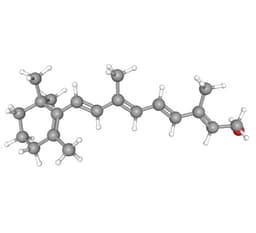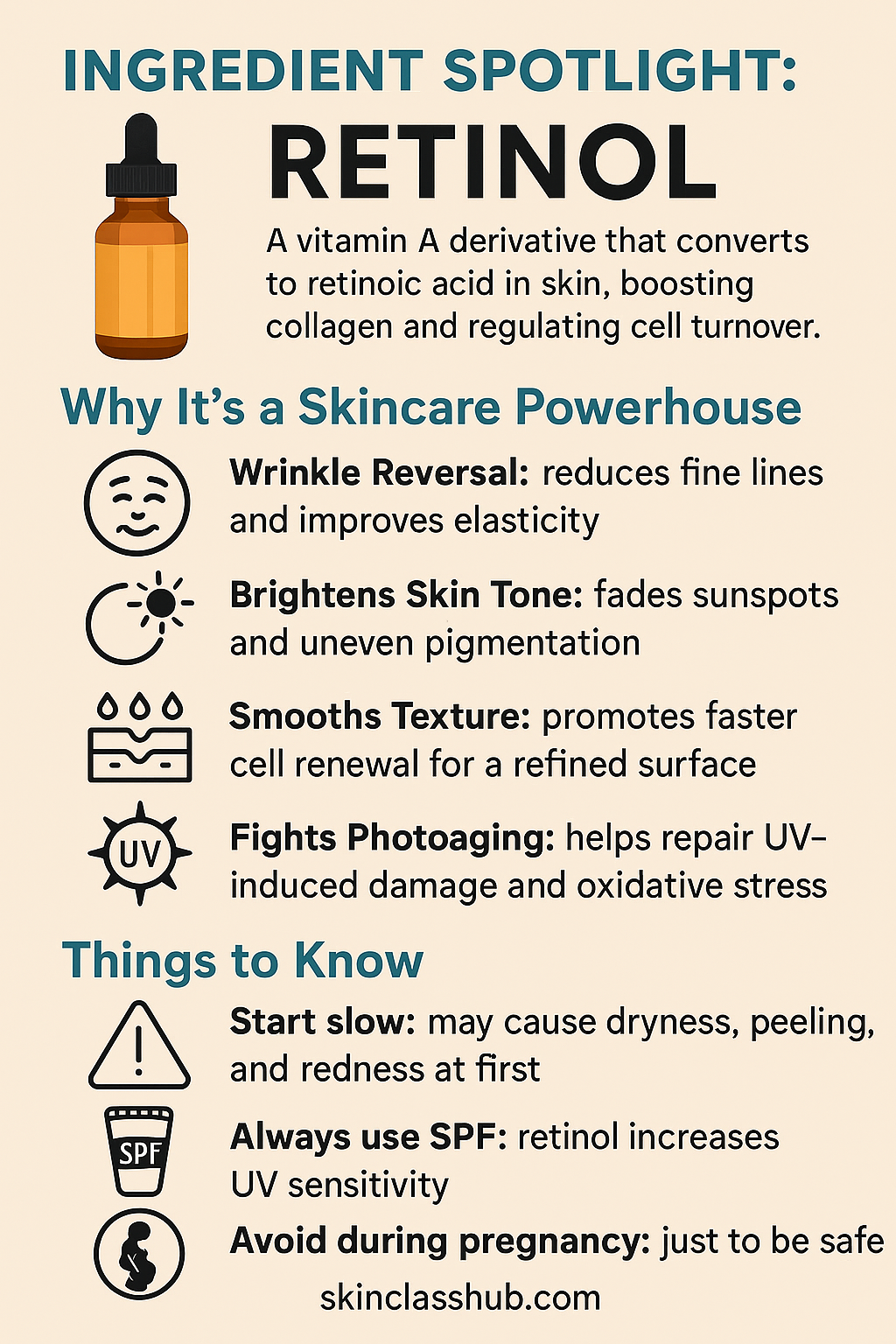Retinol

Summary: A potent form of vitamin A that boosts collagen, smooths wrinkles, and evens skin tone.
Published on: 11/08/2025
Retinol is a fat‑soluble form of vitamin A commonly incorporated in topical skincare to enhance collagen synthesis, regulate cellular turnover, and reduce signs of aging [1].
In skin, retinol is metabolized into retinaldehyde and ultimately retinoic acid. Retinol is chemically unstable—prone to degradation via light and air —necessitating advanced formulation strategies for sustained efficacy [3].
Skincare Benefits
Collagen synthesis & wrinkle reversal
Retinol is one of the very few topical ingredients shown in controlled clinical trials to reduce actual wrinkle depth and fine line count, not just slow aging. A 2020 split-face study using 0.3% and 0.5% retinol applied daily over 12 weeks objectively measured skin surface roughness using imaging systems and found significant reductions in fine wrinkles and overall facial unevenness on both treated sides compared to baseline [4].
In another double-blind, split-face trial, a stabilized 0.1% retinol moisturizer was applied nightly for 8 weeks. Clinical grading on wrinkle severity, pigmentation, elasticity, and firmness showed statistically significant improvements compared to the vehicle—with improvements evident at 4 weeks and increasing through week 8 [5].
Perhaps most notably, a 52-week, vehicle-controlled study of stabilized 0.1% retinol demonstrated a 44% reduction in crow’s-feet fine lines and an 84% improvement in mottled pigmentation—also confirmed by histological increases in type I procollagen and hyaluronan expression in skin biopsies [6]. Together, these studies make retinol one of the very few topical ingredients with replicated clinical evidence for actual wrinkle reversal, not just prevention.
Improved skin texture & hyperpigmentation
Beyond wrinkle reduction, retinol improves skin texture by stimulating keratinocyte activity and increasing epidermal thickness, contributing to a smoother, more even surface [7]. It also helps even out skin tone by reducing excess melanin in the epidermis and improving mottled hyperpigmentation in clinical use [3]. Controlled trials with topical retinol show visible fading of sun-induced pigmentation within 8 weeks [5], with concurrent reductions in hyperpigmentation and unevenness over 12 weeks in instrument-assessed studies [4].
Antioxidant and photoaging mitigation
Experimental studies show that retinol can help skin withstand UVB-induced damage by lowering oxidative stress, reducing inflammatory cytokine release, and promoting DNA repair in keratinocytes [8]. These protective effects target early events in photoaging, potentially slowing the cascade of molecular changes that lead to visible damage over time.
Stability and Delivery Challenges
Retinol undergoes rapid degradation when exposed to air, light, heat, or improper packaging—up to 80% loss within six months at 25 °C, with accelerated degradation under higher temperatures and light exposure [2]. These stability issues require specialized formulation approaches such as liposomes, solid lipid nanoparticles, or silicone encapsulation, which help protect the molecule, enhance penetration, and reduce irritation [10].
Common Derivatives
| INCI Name | Stability | Notes |
|---|---|---|
| Retinol | Low | Unstable in air, light, and heat; requires careful formulation. Converts to retinal then retinoic acid. |
| Retinyl Palmitate | Higher than retinol | Stable ester; converts (slowly, multi-step) to retinoic acid; generally lower potency vs retinol [9]. |
| Retinal (Retinaldehyde) | Low | One step from retinoic acid; higher activity than retinol; less stable than esters; irritation profile similar to retinol, better than tretinoin [9]. |
| Retinoic Acid (Tretinoin) | Low | Active form. Requires no conversion. [9] Most effective and most irritating. Prohibited in EU cosmetics (drug-only) [12] |
Safety and Regulatory Status
Irritation and Photosensitivity
Retinol at cosmetic concentrations (typically 0.1%–1%) can cause dose-dependent irritation, including dryness, erythema, and peeling, particularly during the early weeks of use [10]. Because retinol increases the skin’s sensitivity to UV light, daily use of broad-spectrum sunscreen is strongly recommended during treatment [3].
Regulatory Limits and Prescription Use
In the European Union, the Scientific Committee on Consumer Safety (SCCS) has approved the use of retinol, retinyl palmitate, and retinyl acetate in cosmetics at maximum 0.05% retinol equivalent (RE) in body lotions, and up to 0.3% RE in other leave-on and rinse-off products (including face and hand creams). These limits are intended to prevent topical products from contributing enough vitamin A to push a person’s total daily intake—from both cosmetics and oral sources such as diet and supplements—above the tolerable upper intake level of 3,000 µg RE/day for adults, as excessive vitamin A can cause liver toxicity, bone demineralisation, and birth defects. Unlike what many might expect, these caps are not set to prevent skin irritation, but to control cumulative vitamin A exposure for systemic safety [11].
In contrast, prescription-strength retinoids such as tretinoin are classified as active pharmaceutical ingredients in the EU, US, and many other regions, and are approved only for specific medical indications (e.g., acne, photoaging) under medical supervision due to their higher potency, greater irritation potential, and systemic safety considerations [12].
Pregnancy Precaution
Although systemic absorption from topical retinoids is minimal and there is no conclusive evidence linking topical application to teratogenic effects in humans, their use is contraindicated during pregnancy as a precaution due to the well-established risks of systemic retinoid exposure [3].
Pin it!

Conclusion
Retinol remains one of the most clinically validated cosmetic ingredients for reversing signs of photoaging. Its ability to boost collagen, regulate keratinocyte turnover, and reduce hyperpigmentation has been consistently demonstrated across multiple controlled trials.
However, its instability and irritation potential make formulation quality a critical factor in real-world effectiveness. Choosing well-formulated products— with packaging that respects retinol's stability issues - and introducing them gradually can maximize benefits while minimizing drawbacks.
References
-
Adamantidi, T., Lafara, M.-P., Tsoupras, A., et al. (2025). Utilization and bio‑efficacy of carotenoids, vitamin A and its vitaminoids in nutricosmetics, cosmeceuticals, and cosmetics’ applications with skin‑health promoting properties. Applied Sciences, 15(3), 1657.
https://www.mdpi.com/2076-3417/15/3/1657 -
Rakuša, Ž. T., et al. (2021). Retinoid stability and degradation kinetics in commercial cosmetic products. Journal of Cosmetic Dermatology, 20(7), 2350–2358. https://doi.org/10.1111/jocd.13852
-
Mukherjee, S., Date, A., Weindl, G., et al. (2006). Retinoids in the treatment of skin aging: An overview of clinical efficacy and safety. Clinical Interventions in Aging, 1(4), 327–348.
https://pmc.ncbi.nlm.nih.gov/articles/PMC2699641/ -
Zasada, M., Budzisz, E., et al. (2020). A clinical anti-ageing comparative study of 0.3% and 0.5% retinol serums: A Clinically Controlled Trial Skin Pharmacology and Physiology, 33(2), 102–116. https://pubmed.ncbi.nlm.nih.gov/32428912/
-
Tucker-Samaras, S., Zedayko, T., Cole, C., et al. (2009). A stabilized 0.1% retinol facial moisturizer improves the appearance of photodamaged skin in an eight‑week, double‑blind, vehicle‑controlled study. Journal of Drugs in Dermatology, 8(10), 932–936. https://pubmed.ncbi.nlm.nih.gov/19852122/
-
Tucker-Samaras, S., Zedayko, T., Cole, C., et al. (2015). One-year topical stabilized retinol treatment improves photodamaged skin in a double-blind, vehicle-controlled trial. Journal of Drugs in Dermatology, 14(3), 271–280.
https://pubmed.ncbi.nlm.nih.gov/25738849/ -
Quan, T. (2023). Human skin aging and the anti‑aging properties of retinol. Biomolecules, 13(11), 1614.
https://doi.org/10.3390/biom13111614 -
Zhong, J. et al. (2025). Synergistic effects of retinol and retinyl palmitate in alleviating UVB-induced DNA damage and promoting the homologous recombination repair in keratinocytes. Frontiers in Pharmacology, 16:1562244. https://pmc.ncbi.nlm.nih.gov/articles/PMC12058701/
-
Zasada, M., Budzisz, E. (2019). Retinoids: Active molecules influencing skin structure formation in cosmetic and dermatological treatments. Advances in Dermatology and Allergology, 36(4), 392–397.https://pmc.ncbi.nlm.nih.gov/articles/PMC6791161/
-
Narsa, A. C., Suhandi, C., Afidika, J., et al. (2024). A comprehensive review of the strategies to reduce retinoid-induced skin irritation in topical formulation. Dermatology Research and Practice. https://pmc.ncbi.nlm.nih.gov/articles/PMC11344648/
-
Scientific Committee on Consumer Safety (SCCS). (2022). Opinion on vitamin A (retinol, retinyl acetate, retinyl palmitate) – SCCS/1639/21. European Commission, Health and Food Safety Directorate-General. https://ec.europa.eu/health/system/files/2023-08/sccs_o_261.pdf
-
CosIng (EU Commission) — Retinoic Acid (Tretinoin) entry
Shows “Cosmetics Regulation provisions: II/375” → Annex II (prohibited substances).
Citation: European Commission. CosIng database: Ingredient—RETINOIC ACID (Tretinoin). Annex II/375 (prohibited in cosmetics).
https://ec.europa.eu/growth/tools-databases/cosing/details/85067